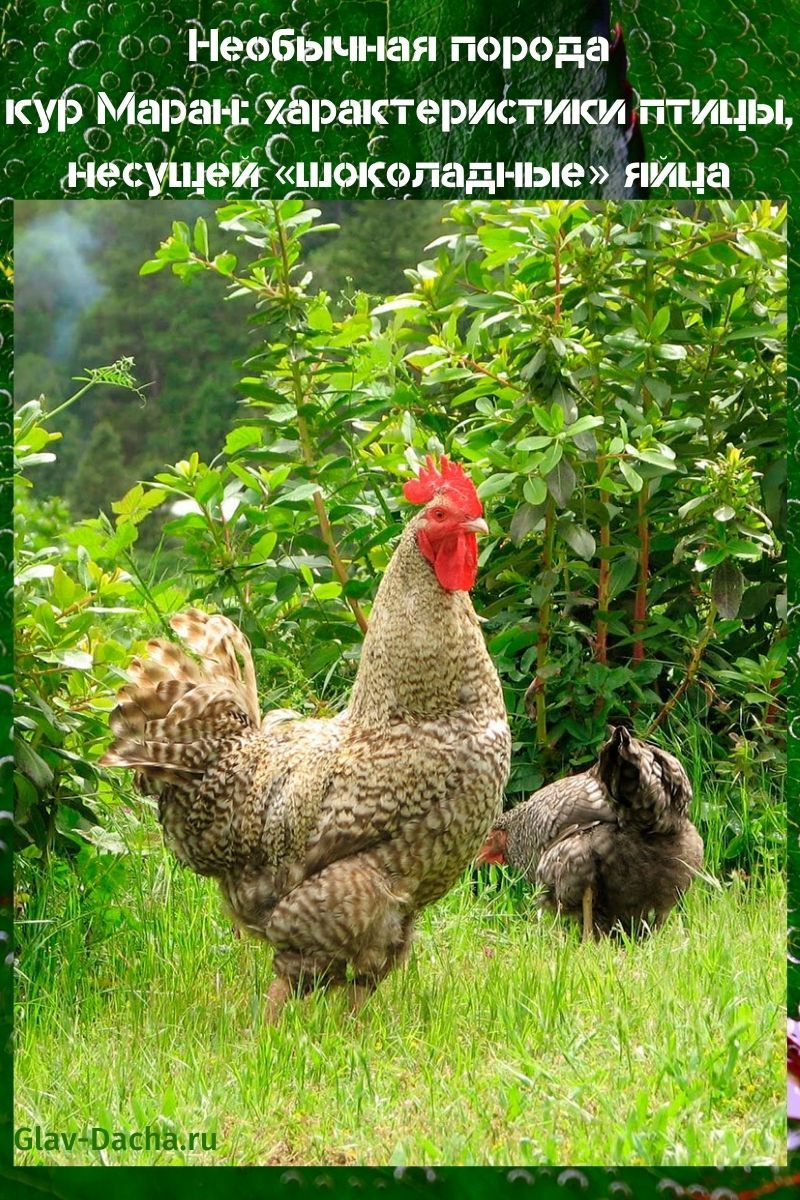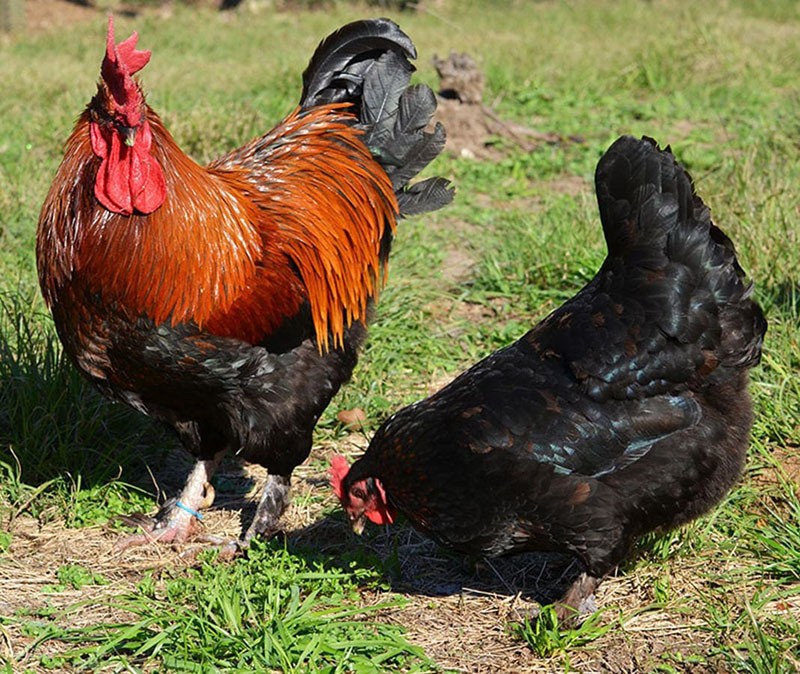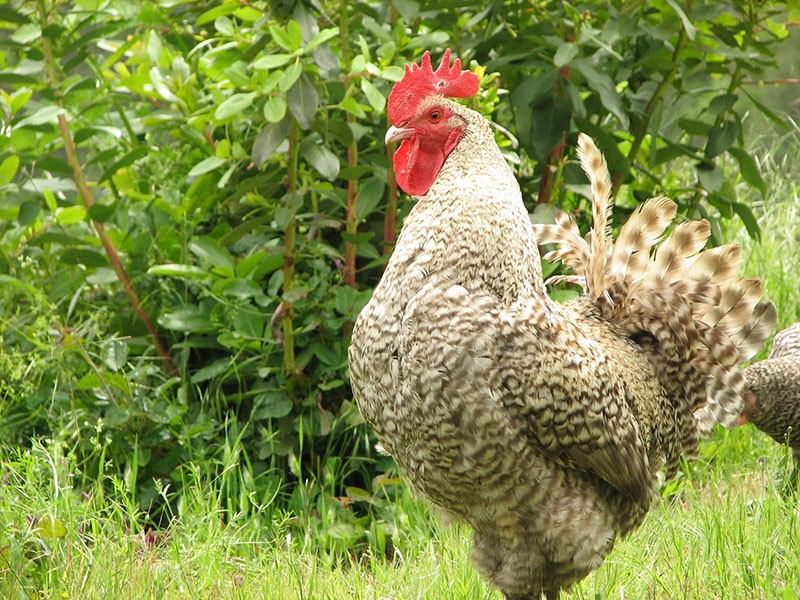Unusual breed of chickens Maran: characteristics of a bird that lays "chocolate" eggs
 There are a huge number of poultry species in the world that have become the pride of the breeders who bred them. These include the Maran chicken breed, the characteristics of taste and egg production of which deserve close attention from farmers.
There are a huge number of poultry species in the world that have become the pride of the breeders who bred them. These include the Maran chicken breed, the characteristics of taste and egg production of which deserve close attention from farmers.
History of the breed

Breed of chickens Maran: characteristics according to French standards
 Maranas are attracted by the unusual beauty of their feathers. Depending on the subspecies of hens and roosters, it is black with a greenish tint, speckled, red. The plumage remains bright throughout the year. The birds are massive, with dense feathers, which gives them a plump, stately appearance. Moreover, they do not seem clumsy and clumsy. Maranas are distinguished by good adaptive abilities, they easily adapt to changing weather conditions. Even in winter, in a slight frost, they calmly walk in the fresh air.
Maranas are attracted by the unusual beauty of their feathers. Depending on the subspecies of hens and roosters, it is black with a greenish tint, speckled, red. The plumage remains bright throughout the year. The birds are massive, with dense feathers, which gives them a plump, stately appearance. Moreover, they do not seem clumsy and clumsy. Maranas are distinguished by good adaptive abilities, they easily adapt to changing weather conditions. Even in winter, in a slight frost, they calmly walk in the fresh air.
In most countries of the world there are Maran breeders' clubs, in which requirements are imposed on the exterior of the bird. They are guided by the description of the Maran breed by its breeders - the French.
According to standards, the bird must have the following characteristics:
- bright orange iris of the eye;
- lobes and earrings are red;
- slightly bent strong beak;
- wide, powerful chest;
- medium-sized head with a bright red leaf-like crest;
- small wings that fit tightly to the body;
- massive neck with abundant plumage;
- fleshy thighs and legs;
- short tail;
- wide back, raised in the lumbar region;
- elongated body with wide shoulder girdle.
- the weight of an adult rooster is almost 4 kg, chickens reach 2.5-3.3 kg.
There are dwarf varieties of the Maran chicken breed. The same standards apply to them, only they relate to dimensions. The weight of the dwarf maran is 1.1 kg, the chicken is 900 g. Birds that do not meet these criteria must be discarded.
Features of meat and eggs Maranov
 Maran eggs are distinguished by a strong shell of a rich chocolate shade. This is good for sellers, since eggs are not damaged during transportation, and harmful dangerous microorganisms do not penetrate into them. The French do not hesitate to eat dark brown eggs raw precisely because of their thick shell. Moreover, it is believed that the richer the chocolate color of the eggs, the higher their quality.
Maran eggs are distinguished by a strong shell of a rich chocolate shade. This is good for sellers, since eggs are not damaged during transportation, and harmful dangerous microorganisms do not penetrate into them. The French do not hesitate to eat dark brown eggs raw precisely because of their thick shell. Moreover, it is believed that the richer the chocolate color of the eggs, the higher their quality.
 Young laying hens Marana lay their first eggs after puberty (at 5-6 months). At first, they turn out to be small (no more than 60 g) and not so saturated in color.After a year, a young laying hen gives up to 250 dark eggs (but not less than 130) weighing an average of 85 g, and with an enhanced and balanced diet, good keeping conditions, egg production rates increase.
Young laying hens Marana lay their first eggs after puberty (at 5-6 months). At first, they turn out to be small (no more than 60 g) and not so saturated in color.After a year, a young laying hen gives up to 250 dark eggs (but not less than 130) weighing an average of 85 g, and with an enhanced and balanced diet, good keeping conditions, egg production rates increase.
 The quality of Maran eggs is determined by the saturation of the color of their shell. France has developed a 9-tone scale. Light brown to almost charcoal. A good quality egg should get at least 5 points (for hatching eggs, the score should be at least 7). Eggs with 9 points are considered the best. They are characterized by a deep black coloration reminiscent of coal. Novice farmers suggest that the unusual coloration is due to the feeding of the birds with various additives. But this is not the case. The shell is painted in the original color with a brown mucous secretion released from the walls of the laying hen's oviduct.
The quality of Maran eggs is determined by the saturation of the color of their shell. France has developed a 9-tone scale. Light brown to almost charcoal. A good quality egg should get at least 5 points (for hatching eggs, the score should be at least 7). Eggs with 9 points are considered the best. They are characterized by a deep black coloration reminiscent of coal. Novice farmers suggest that the unusual coloration is due to the feeding of the birds with various additives. But this is not the case. The shell is painted in the original color with a brown mucous secretion released from the walls of the laying hen's oviduct.
Maran meat is appreciated by gourmets all over the world. In the carcasses of French chickens, buyers are attracted by the soft pink skin and dense, juicy meat with a small amount of fat in the tail area. It is ideal for broth, stewing, roasting, boiling and frying.
Variety of color
 The French do not recognize many Maran colors. For them, the standard is a bird with a well-remembered appearance. These are tall, dense Black-copper roosters and hens. In the USA, all feather colors of birds of this breed are recognized as the standard.
The French do not recognize many Maran colors. For them, the standard is a bird with a well-remembered appearance. These are tall, dense Black-copper roosters and hens. In the USA, all feather colors of birds of this breed are recognized as the standard.
The most beautiful are:
- Black and copper. The most popular of the Maran chicken breed is the Black-Copper type of bird. The male is coal-colored with a fiery mane and a reddish tint on the back. His tail is dark with a blue tint. Layers are completely black, only on the neck there is a red rim.

- Black-tailed. The body of birds with a golden-purple tint. Tail feathers are black with small brownish spots. Roosters have beautiful iridescent green pigtails. Laying hens have brownish feathers.

- Wheat Maran. Roosters with black breasts, the head and neck are bright golden. The color of the feathers along the contour is reddish brown. Chickens are distinguished by golden-red feathers. The head and neck are light brown. Feathers on the chest and belly are beige.

- Colombian. These birds are distinguished by snow-white feathers and down on the body. A black mane with a white stripe surrounds the neck.

- Cuckoo. Maran Wheat can be silver and golden cuckoo. In the first case, the roosters have a clearer and more vivid pockmarked pattern, in the second, the laying hen is distinguished by a high-definition pattern. Birds of both sexes have variegated plumage, but roosters are lighter than layers in the chest and neck area.

Necessary conditions for keeping Maranov
 Maranam needs poultry house, in which they will be warm, dry, light. Birds do not tolerate high humidity, they need at least 11 hours of daylight hours and temperatures above +15. The chicken coop is aired daily or equipped with an extractor hood so that moisture does not accumulate in the room, otherwise it will lead to the development of diseases. Be sure to install sawdust bedding, which is changed 2 times a week.
Maranam needs poultry house, in which they will be warm, dry, light. Birds do not tolerate high humidity, they need at least 11 hours of daylight hours and temperatures above +15. The chicken coop is aired daily or equipped with an extractor hood so that moisture does not accumulate in the room, otherwise it will lead to the development of diseases. Be sure to install sawdust bedding, which is changed 2 times a week.
Maranas are active birds, therefore, they need a spacious area for walking. Lack of movement leads to obesity, decreased productivity and threatens the life of birds. Dry baths must be organized on the walking area, installing large containers with dry sand and ash. In them, Maranas clean feathers and down from parasites. The aviary is half covered with a canopy so that the birds hide during the rain or snow. This will save them from colds.
Although the breed was bred for regions with a cool climate, for keeping Maran chickens in winter, they are provided with comfortable conditions with the help of the following modifications to the chicken coop:
- Installation of additional lighting. Birds need 14 hour daylight hours, so in winter they use artificial lighting, preferably with a relay that independently turns off and turns on the light at a given time.
- Warming. For good egg production, Maranam requires a temperature of at least +10 degrees.In winter, a thick layer of straw is placed in the hen house and heaters are installed.
Feeding
 The diet of Maranov is made up according to the same principle as for other chicken breeds. The main thing is that it is balanced, otherwise the number of eggs will decrease. Farmers are especially attentive to the development of nutrition for young animals. Height, weight gain, health of future layers and roosters directly depends on it.
The diet of Maranov is made up according to the same principle as for other chicken breeds. The main thing is that it is balanced, otherwise the number of eggs will decrease. Farmers are especially attentive to the development of nutrition for young animals. Height, weight gain, health of future layers and roosters directly depends on it.
Maranov's day-old chickens need enhanced nutrition:
- From birth to the third day, they are fed with cottage cheese mixed with boiled eggs, crushed into crumbs. They are given this protein shake every 2 hours.
- From the third day, wheat and corn grits are added to the feed.
- On the 6th day, finely crushed egg shells are introduced. Chickens are fed 6 times a day.
- On day 10, the number of feedings is reduced to 4, the nutrition is enriched with grated carrots, chopped and scalded grass (clover, alfalfa).
- Beets are added from one month old.
- Young animals are transferred to adult nutrition from 3 months.

As a prophylactic agent against intestinal diseases, chickens are given a weak solution of potassium permanganate once a week.
Adult chickens and roosters are fed several times a day. If the diet mostly consists of compound feed, then 60-75 grams of food per day per bird. Maranas need chopped vegetables, fresh grass. The saturation of the color of the egg yolk depends on the amount of grass consumed by the laying hen. The diet of adults is 30% protein and 70% carbohydrates. Young layers are fed with special commercial calcium supplements. Or they give bone meal, crushed eggshells, bone meal, shell rock.
 Compound feed is bought ready-made or prepared independently. In this case, 45% of it is maize grains, 12% wheat grains, 8% peas, 7% each of fodder chalk, sunflower meal, limestone, shell rock, barley grains, 5% each of fodder yeast, bone meal and fish meal, grass, 0, 3% salt. Birds are placed in a chicken coop containers with quartz sand and gravel. These hard rocks are essential for Maran to digest food better.
Compound feed is bought ready-made or prepared independently. In this case, 45% of it is maize grains, 12% wheat grains, 8% peas, 7% each of fodder chalk, sunflower meal, limestone, shell rock, barley grains, 5% each of fodder yeast, bone meal and fish meal, grass, 0, 3% salt. Birds are placed in a chicken coop containers with quartz sand and gravel. These hard rocks are essential for Maran to digest food better.
Disease prevention
 Maran chickens suffer from diseases common to many poultry.
Maran chickens suffer from diseases common to many poultry.
Among them:
- helminthiasis;
- feather eaters;
- chicken lice;
- inflammation of the oviduct in layers;
- avitaminosis;
- Knemidocoptosis (bumps on the paws caused by ticks).
To prevent diseases, birds are vaccinated in a timely manner, provide them with adequate nutrition, comfortable living conditions, and regularly examine birds. If signs of a disease are found, they seek help from a veterinarian for treatment.
The excellent characteristics of the Maran chicken breed on the part of their owners makes them want to buy a French miracle. These are stress-resistant birds, easily adapting to new surroundings. They are especially appreciated for their calmness. A complete idyll is observed in the hen house among Maranov. Roosters keep order, hens do not make much noise. The birds are non-aggressive, so they are easy to breed with other breeds.